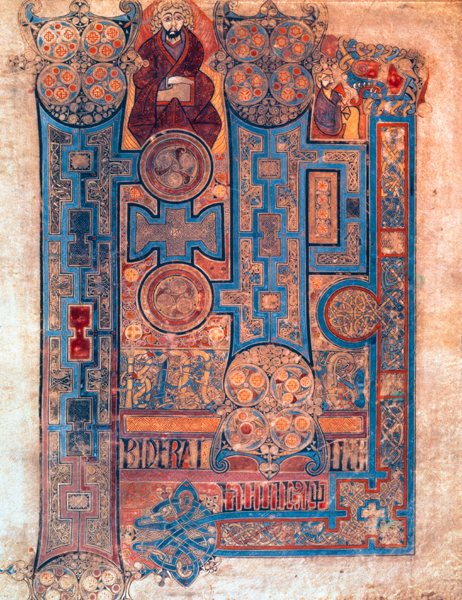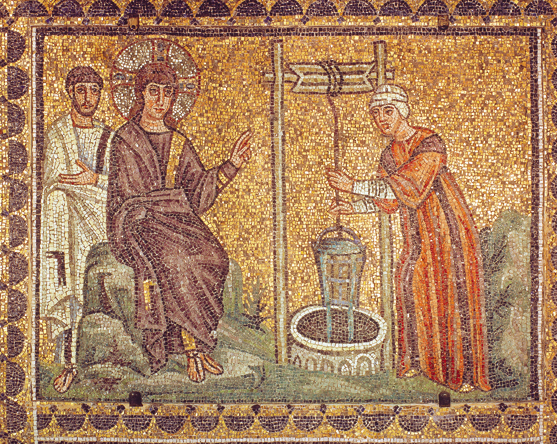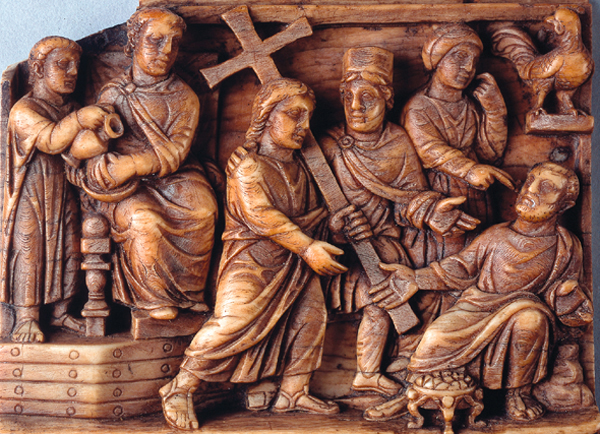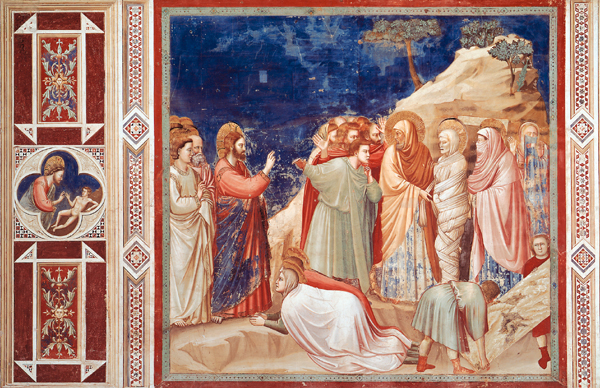The Un-Gospel of John
012

“In the beginning was the Word, and the Word was with God, and the Word was God. The same was in the beginning with God” (John 1:1). With this wonderfully poetic opening verse, John sets the tone for his entire gospel and defines its vast scope. The Word that God speaks in the life of Jesus is the same Word God uttered at Creation’s start. This is the very Word that created heaven and earth, beast and bird, man and woman. For God spoke, “Let there be light,” and there was light.
014
In his opening verse, John calls listeners to worship—that strange place halfway between earth and heaven, where divine secrets are revealed to mankind. John’s first lines may well have been a hymn, recited Sunday after Sunday in Ephesus, where some believe John lived 60 years after Jesus’ death.
We have moved a long way from the first three gospels (known as the Synoptics because they share so much).a We have shifted from the nitty-gritty of Jesus’ daily life to grand concepts of Light, Life and Truth. The brisk dialogue and memorable sayings of the Synoptics are replaced with long, circuitous—some might even say rambling—discussions. The rapid series of short, sharp stories in the first three gospels give way to a handful of elaborate set pieces in John.
So great is the chasm between the Synoptics and John that many readers have characterized their relationship as literal vs. allegorical and history vs. myth: The Synoptics narrate the life of the man known as Jesus, John reveals the mythic hero. This contrast is chiefly favored by readers looking for the “historical Jesus.” Such readers go to the Gospels as archaeologists go to a dig—in particular, as archaeologists who are looking for the site’s earliest layer and nothing else. Such digging has been immensely fruitful over the last 100 years. But archaeology is not the only critical discipline. Readers of the New Testament would do well to consult, too, the professors of poetry, of liturgy and of the philosophy that asks, “What can we know and how can we come to know it?” In this article, let us start with archaeology—and then move on.

015
Of course, there is some straightforward common ground between John’s gospel and the other three. Jesus is still a miracle worker and teacher; he is crucified and rises again; his closest pupils still have the same names. But dig beneath this surface, and we find a strange tangle of roots. Half the stories that John tells of Jesus’ ministry do not appear in the Synoptics. John alone recounts the wedding at Cana (John 2:1–11), the washing of the disciples’ feet (John 13:1–20) and various scenes in Jerusalem before Jesus’ triumphal entry into the city (John 5, 7–10). The cleansing of the Temple appears in all four Gospels, but the first three have it at the end of Jesus’ ministry; John places it right at the start (John 2:13–22). John tells the story of Lazarus being raised from the dead at the climactic center of his book (John 11); the other gospels never mention it at all. John does not tell of the Last Supper, but he seems to know the story well; Jesus speaks of the need to eat his flesh and drink his blood (John 6:51–58).
All the Gospels recount the crucifixion, of course, but in Mark and Matthew, Jesus appears to die in despair, crying out, “My God, my God, why have you forsaken me?” (Mark 15:34; Matthew 27:46).b Luke’s Jesus dies an innocent sage and martyr: “Father, unto your hands I commit my spirit” (Luke 23:46). In John, Jesus dies in supreme control. The night before he is crucified, he recognizes that “the hour has come” (John 17:1). He was sent to reveal the 016Father’s splendor and has done so. His last words on the cross are simply, “It is completed” (John 19:30).
No wonder readers have been led to question whether John’s Jesus is human at all.1
To see the problem at its sharpest, let’s put Mark’s Jesus side by side with John’s.
In the Gospel of Mark, Jesus’ knowledge and powers are limited. In Mark, Jesus has some knowledge of the future, but it is incomplete. He knows, for example, that the disciples James and John will meet deaths as violent as his own (Mark 10:39). He tells his innermost circle of the destruction threatening Jerusalem, which will be part of a worldwide cataclysm (Mark 13). Yet he doesn’t know when this devastation will occur: “About the day” on which this will happen “or the hour,” he must confess, “no one knows: neither the angels in heaven nor the Son, only the Father” (Mark 13:32). Jesus’ authority is limited in Mark: He cannot promise to seat James or John beside him when he is enthroned in splendor; it is simply not “within [his] gift” (Mark 10:40).
The healing powers of Mark’s Jesus are finite, too. In his homeland he can heal just a handful of invalids, for the people have no trust in him. “Prophets are not without honor, except in their hometown,” admits Mark’s Jesus (Mark 6:4). His power can even be sapped. Jesus senses that strength has left him when the hemorrhaging woman surreptitiously touches his clothing and is healed (Mark 5:30).
Mark does not reveal much about Jesus’ feelings, but when he does we see Jesus’ very human reactions to suffering, whether that of others or his own. Twice we read that Jesus was struck with pity—once at the sight of a leper (Mark 1:41),2 once by the sight of so many hungry, aimless people resembling “sheep without a shepherd” (Mark 6:34). Once we hear how Jesus felt in the face of opposition. When a man with a crippled hand appeared in synagogue one Sabbath, Jesus asked those around him: “Is it right to do good on the Sabbath or to do harm, to save life or to destroy it?” When no answer came, Jesus “looked around him with anger, deeply upset by their hardness of heart,” and healed the man’s hand (Mark 3:5). In Mark 8:11, Jesus “sighs deeply.”
At the climax of his gospel, Mark allows us to witness Jesus’ inner turmoil. “Father,” Jesus pleads before his arrest, “for you all things are possible. Remove this cup from me. Yet not my will, but yours, be done” (Mark 14:36). For a moment, Jesus seems as vulnerable as any ordinary human being. As he hangs on the cross, Mark’s Jesus cries out the stark opening line of Psalm 22, “My God, my God, why have you forsaken me?” (Mark 15:34).
John’s Jesus, in contrast, never loses control of his situation or of those around him. He maintains this control in part by his knowledge. Jesus “knew everyone, and had no need for anyone to testify about people; for he himself knew what was in them” (John 2:23–25).

In the Gospel of John, Jesus asks the Samaritan woman for water, but he does not really need it. He has drink of his own, drawn from the spring of “eternal life” (John 4:7, 10–14). He thirsts on the cross, but only, as John makes clear, “so that the scripture might be fulfilled” (John 19:28, alluding to Psalm 69:21, “For my thirst they gave me vinegar to drink”).
This Jesus has been given the power to give life and to judge, the prerogatives of God himself (John 5:21ff.). He says that “The father is greater than I” (John 14:28); but he also says, “I and the Father are one” (John 10:30). 018He speaks of himself with a shortened form, also used by Isaiah, of the divine name that God revealed to Moses: “I AM WHO I AM” (Exodus 3:14). “Very truly, I tell you,” says Jesus, “before Abraham was, I AM” (John 8:58).


Mark’s Jesus was distraught on the last night of his life; John’s resolves his hesitation before the story is halfway through. Here John seems to be deliberately rewriting the Marcan tradition in which Jesus prays to be saved from the hour of suffering. In John, Jesus renounces the wish before it is even spoken:
“What should I say, ‘Father, save me from this hour?’
But it is just for this that I have reached this hour.
Father, glorify your name.”(John 12:27–28)
John’s Jesus knows “all that was to happen to him” (John 18:4) and lets the drama take its course. He does not pray in the garden before his arrest. Judas does not touch him. As the band of men arrives, Jesus comes forward and asks, “Who are you looking for?” When they reply, “Jesus of Nazareth,” Jesus says simply, “Here I am” (John 18:6), and the soldiers fall backward to the ground.
Jesus’ death is no defeat. He tells his disciples:
This is why the Father loves me,
because I lay down my life,
so that I might take it up again.
No one takes my life from me,
but I lay it down of my own accord.
I have the power to lay it down,
and I have the power to take it up again.
This is the command I have received from my Father.(John 10:17–18)
How can a human being have such power?
Long before modern scholars, the early church fathers realized that some explanation was needed for John’s divergence from the other gospels.
“Last of all,” St. Clement of Alexandria wrote in about 200 C.E., “John, perceiving that the external facts had been made plain in the gospels, being urged by his friends and inspired by the Spirit, composed a spiritual gospel.”3 The other gospels, Clement suggested, tell the story “from the outside”; John reveals the heart of Jesus.
In about 235 C.E., Origen, following the tradition that identified the evangelist John as the “beloved disciple” 020(see the sidebar to this article), wrote that because John once reclined upon the bosom of Jesus (John 13:25, 21:20), he was able to unveil the deepest truths of the gospel story.4 According to this theory, John might well have been the last gospel to be finished (today most scholars date it to 90–100 C.E.), yet it preserves the earliest, the deepest and the most faithful recollections of Jesus.5
There are two main objections to such a view. First, is it really credible that the rest of the church would so completely have lost sight of Jesus’ “real” character? The stories that were built into the Synoptic Gospels had also, after all, been relayed by Jesus’ closest friends: Mark, for instance, is said to have learned the old traditions from the disciple Peter.
Second, although John may be unique among the Gospels, within a wider setting the text is not as unusual as was once believed. Today, we know that John bears striking similarities to certain scrolls from Qumran; to The Odes of Solomon, a collection of Christian hymns dating to about 100 C.E.;6 and to the Gospel of Truth, a gnostic homily of the mid-second century C.E.7 The Dead Sea Scroll known as the Community Rule, which dates to about 100 B.C.E. and lays out the sectarian rules for the community that produced the scrolls, ends with a hymn that recalls both Paul and John:
All things have come to pass
by God’s knowledge;
he establishes all things by his design
and without him nothing is done.8
Is it here—and not at Jesus’ bosom—that the first ideas were formed that would lead to John’s Prologue?
In The Odes of Solomon, too, we seem to breathe the air of John’s Prologue:
His Word is with us in all our way,
the Savior who gives life
and does not reject ourselves.
The Man who humbled himself,
but was raised because of his own righteousness.
The Son of the Most High appeared
in the perfection of his Father.
And light dawned from the word
that was before time in him.
The Messiah in truth is one.
And he was known
before the foundations of the world,
that he might give life to persons forever
by the truth of his name.9
What are we to make of these similarities? The pieces in the jigsaw can be put together in so many ways. Perhaps Jesus was himself influenced by Qumran and even spent time in the community. Perhaps The Odes of Solomon were influenced by John’s gospel. Perhaps John has discovered, thanks to his broad 021education, ways of describing Jesus that do Jesus more justice than any straightforward retelling of the story could do. After all, sociologists, psychologists and anthropologists can claim that in some ways they understand their subjects better than the subjects understand themselves. Or perhaps we have to give up such special pleading. Then we might simply admit: John’s Jesus has been so thoroughly influenced by the cares and crises of John’s own time that we learn from the gospel more about the theology and politics of the 90s C.E. than about life in the 30s C.E.
Scholars have long argued—and perhaps assumed—that the churches’ view of Jesus’ status “rose” during the first century. The process continued: By the fifth century the doctrine was widely held that Jesus was truly God and truly man. One familiar reconstruction of how the beliefs of the various early churches developed runs as follows.c
Mark, finished in the 60s C.E., shows the most “primitive” view of Jesus: This Jesus still has the limitations of a human being. Mark is not overly concerned with the origins of this earthly Messiah; he does not even include a birth narrative.
For Matthew and Luke, finished in the 70s or 80s C.E., there is more to be explained. Who must this Jesus have been from his very conception to have achieved so much in his life and through his death? Luke and Matthew show inklings of the view of Christ fully developed in John. In Matthew, Jesus says:
All things have been given over to me by my Father;
And no one really knows the Son except the Father,
and no one really knows the Father except the Son,
and anyone to whom the Son wishes to unveil him.(Matthew 11:27=Luke 10:22)
Furthermore, when read in this order, the Gospels seem to show a widening separation between Jesus’ followers and the synagogue. In Mark the arguments with the synagogues are festering (Mark 13:9, for instance). In Matthew they are blazing (Matthew 27:25). Luke must still explain why the Christians have broken away from the synagogue (Acts 13:46–47, 18:6, 28:25–28). John, finally, must encourage those suffering from a decree that anyone who acknowledged Christ was to be expelled from the synagogue (John 9:22, 34, compare 12:42).10
In this reconstruction, John is the final stage in the process that leads (heavily under John’s influence) to the church’s formulation of doctrine in the fourth and fifth centuries.
Is John the last stage or the first? Is John the gospel in which we encounter Jesus as remembered by his closest friend? Did Jesus make these dazzling claims for himself and his relation to the Father? Or does the story of Mark relay most accurately the impression that Jesus’ style and teaching and claims made even upon his closest friends? Is John, then, the gospel in which one church, of the 90s C.E., arrives at the view of Jesus that will serve as the foundation of the later creeds?
These are old and important questions. Surprisingly, however, we still may not be in a position to answer them. For in all the shelves of books devoted to John’s gospel, there are very few volumes that ask, What sort of text have we before us here? Perhaps John is neither first nor last, but other.
John’s book is about knowledge. John is not showing his readers just what to know but how to know it. He is not presenting only new thoughts but a new way of thinking. How are John’s readers to attain this new way?
“Unless people are born again from above,” Jesus explains to the Pharisee Nicodemus in John 3:3, “they cannot see the kingdom of God.” Nicodemus struggles to understand—and fails. “Can one enter a second time into the mother’s womb and be born?” Nicodemus asks Jesus (John 3:4). It is a difficult concept, and John knows this. So, at the middle of his gospel, at its climax, John provides an example, one missing from the Synoptics: Lazarus is born again.

Lazarus has been dead four days when Jesus arrives at his tomb and orders that the blocking stone be removed from the entrance. “‘Lazarus,’ cried Jesus in a loud voice: ‘Come out’” (John 11:43). “The dead man came out, his hands and feet bound with strips of cloth, and his face wrapped in a cloth” (John 11:44). It is a strange yet simple story: Lazarus hears Jesus’ voice, recognizes it and is reborn.
Rebirth, according to John’s gospel, is available to all who hear Jesus’ word. Jesus explains:
Whoever hears my word
and believes in him who sent me
has eternal life
and does not come to judgment,
but has passed from death to life.
Very truly I say to you,
the hour is coming and is now here
when the dead shall hear
the voice of the son of God,
and those who hear shall live.(John 5:24–25)
In a famous article, Yale University professor Wayne A. Meeks argued that John’s gospel was designed to fulfill the same function in its community that John’s Jesus fulfills in the story.11 John’s Jesus heals, gives sight and brings the dead to life. And that is exactly 046what his gospel is intended to do in its turn. To be reborn, however, readers must not just learn about Jesus, they must hear his voice, experience his power and, like Lazarus, “come out.” What Lazarus undergoes in the story, John’s reader is to undergo in reading it. John is the “midwife” of this new “birth from above.”
John’s gospel is an apocalypse, an “unveiling.” He is unveiling heavenly truths that should be available only to privileged seers in heaven and offering them to all his readers and listeners on earth—if only they will open their eyes and see. Jesus, claims John, is the perfect and total self-disclosure of God in human form. This is hard to express and hard to grasp, as John well knows. He works in every line to maintain the balance he needs. Is Jesus most human when he weeps at the tomb of Lazarus? Or is this the moment at which we see God most clearly?
Paradoxically, when we begin to understand the Jesus of John’s gospel this way, we begin to see that he is closer than we thought to the Jesus of the Synoptic Gospels. Mark, in the 60s, was as awed as John by the figure he was writing about. Mark’s Jesus walks on the waves, as only God can do (Job 9:8). He “makes as if to pass his disciples by” just as God passed Moses by on Mount Sinai (Exodus 33:21, 34:6). He is “the Son of Man”; for Greek-speaking readers, this could only be understood as an allusion to the “one like a son of man” (Daniel 7), who belongs to the heavenly realm. And yet, Mark’s Jesus walks here on earth. All that hid God from humankind is ripped apart. At Jesus’ baptism in Mark, the heavens are torn open; at the crucifixion, the veil of the Temple is torn from top to bottom. Mark, like John, is providing his readers with an “apocalypse.”
Modern scholars need new terms to describe John’s aim and techniques, and new studies to clarify the different ways in which, for all different sorts of readers, his goal may or may not have been achieved. But put crudely: The gospel sets out in the first half to take its readers “through” the process of new birth, climaxing in the birth of Lazarus. Only then are readers prepared to hear the esoteric discourse of John and his disciples in the second half (John 13–17). From the very start we are called into the world of poetry. We can see now how much this poetry is used to achieve.
By the gospel’s end, John has prepared his readers for the resurrection, the most mysterious moment of all, the moment that has made new birth possible for his readers.
John’s gospel started somewhere between heaven and earth, in the garden, at the dawn of all creation. It ends similarly, in a garden, with another dawn approaching. Once again, it is the first day of the week, very early, when it is still dark. Here too, we are reminded of the scope of this “gospel.”

Mary Magdalene, whom we have not met before in John’s gospel, arrives at Jesus’ tomb but finds it empty. She runs to tell Peter and the disciple whom Jesus loved. They come to the tomb in turn and enter it. They see the grave-clothes, heavy with the scent of myrrh and aloes. The men “believe” and go home (John 20:8–10).
But Mary remains outside the tomb. “Mary stood at the tomb. As she wept, she stooped down facing the tomb. And she saw two angels, sitting where the body of Jesus had lain…And they said to her, ‘Woman, why are you weeping?’…‘Because they have taken my lord, and I do not know where they have put him’” (John 20:11–13).
The light is rising. “God said, ‘Let there be light’” (Genesis 1:3). “And the light,” John tells us in his opening hymn, “shines in the darkness, and the darkness has never put it out” (John 1:5).
Here in the garden, “Mary turned round and saw Jesus standing there, but did not know that it was Jesus. ‘Woman,’ said Jesus, ‘why are you weeping? Whom are you looking for?’” She thinks he is the gardener and says, “Sir, if you have taken him away, tell me where you have put him and I will take him away” (John 20:14–15).
Ever searching, Mary reaches out for Jesus. But that is not the love Mary must have for Jesus now. He refuses her sensuous touch: “Do not hold on to me” (John 20:17).
Another garden is recalled throughout these pages: the garden of love of the Song of Solomon. This garden, too, is heavily scented with myrrh and aloes.
“Upon my bed by night I looked for him,” sings the bride in the Song of Solomon. “I will get up and will walk around the city and will look for him whom I love with all my soul…I had scarcely left the watchmen, when I found him whom I love with all my soul; I took hold of him and will not let him go” (Song of Solomon 3:1, 2, 4).
The garden of the Song of Solomon, the garden of Jesus’ betrayal, the garden of Easter morning—underlying them all is the very first garden:
And God planted a garden in Eden…And out of the garden God made to grow every tree that is pleasant to the sight and good for food…God took the man and put him in the garden of Eden to till it and keep it.
(Genesis 2:8, 9, 15)
The first Adam was to till and keep the 047garden of Eden. Who, then, is this “gardener” that finds Mary weeping in his garden at dawn?
In Eden, the serpent had lurked and deceived humankind. On the night before the crucifixion, a “serpent” named Judas had entered the garden of betrayal, to guide the band of men that would take Jesus to his death. But in this garden on Easter morning, there is no serpent; Satan’s power is undone. This is the first day of a new creation.
Then God said, “It is not good that the man should be alone. I will make a helper suitable for him.” So out of the ground God formed every beast of the field and every bird of the air, and brought them to the man to see what he would call them. And whatever the man called every living creature, that was its name.
(Genesis 2:18–19)
Jesus’ disciples check the evidence, “believe” and depart. Mary is left behind and disregarded. She has misunderstood the empty tomb; she looks still for Jesus’ body; she does not know him when he stands before her; she longs for an earthly love and a human touch. But it is not to the knowing disciples that Jesus first appears. It is to Mary Magdalene. For in that inconsolable weeping is the voice of love.
For love is strong as death…
Many waters cannot quench love,
neither can the floods drown it.(Song of Solomon 8:6, 7)
In the Gospel of John, Adam and Eve are once more in Eden. This Adam, too, has a further task: to give the most precious of all God’s “creatures” a name. For then at last will all creation be made new. “Jesus says to her, ‘Mary’” (John 20:16).
“In the beginning was the Word, and the Word was with God, and the Word was God. The same was in the beginning with God” (John 1:1). With this wonderfully poetic opening verse, John sets the tone for his entire gospel and defines its vast scope. The Word that God speaks in the life of Jesus is the same Word God uttered at Creation’s start. This is the very Word that created heaven and earth, beast and bird, man and woman. For God spoke, “Let there be light,” and there was light. 014 In his opening verse, John calls […]
You have already read your free article for this month. Please join the BAS Library or become an All Access member of BAS to gain full access to this article and so much more.
Already a library member? Log in here.
Institution user? Log in with your IP address or Username
Footnotes
The term synoptic, from the Greek for “seeing together,” refers to the fact that the Gospels of Matthew, Mark and Luke share so much material that when printed side by side in three parallel columns their correspondences can be “seen together” at a glance.
For more on these differences, see John Dominic Crossan, “Why Christians Must Search for the Historical Jesus,” BR 12:02.
Endnotes
Within modern scholarship, the question was first raised in 1847 by the great theologian Ferdinand-Christian Baur of Tübingen, who denied that John’s Jesus could responsibly be described as “human” at all.
We need not restrict the case to esoteric truths about Jesus. Aileen Guilding (The Fourth Gospel and Jewish Worship [Oxford: Clarendon Press, 1960]) has argued that the discourse of John 6:35–50 draws on texts that would have been familiar from the Jewish lectionaries of the time.
Behind this discourse, then, may lie a homily expounding such texts. Must we assume that such a “homily” found in the gospel was a later Christian composition? No, claims Raymond E. Brown (The Gospel According to John, [New York: Doubleday, 1966], vol. 1, pp. 278–280). Why should it not have been a homily of Jesus himself?
In 1985 John A.T. Robinson (The Priority of John, [London: SCM, 1985]) explored the possibility of giving John “procedural” priority over the other gospels: Instead of fitting John into the Synoptic framework, he proposed to fit the Synoptic Gospels into John’s. The result, he claimed, was utterly compelling.
James Charlesworth, The Old Testament Pseudepigrapha, vol. 2 (Garden City, NY: Doubleday, 1985), pp. 725–771. The hymns were once thought to have been reworkings of pre-Christian hymns.
James M. Robinson, The Nag Hammadi Library in English (New York: Harper Collins, 1988), pp. 38–51.
The Community Rule XI.11, Geza Vermes, The Complete Dead Sea Scrolls in English (New York: The Penguin Press, 1997), p. 116.
Classically J. Louis Martyn, History and Theology in the Fourth Gospel (New York: Harper & Row; 1968, 1979).
